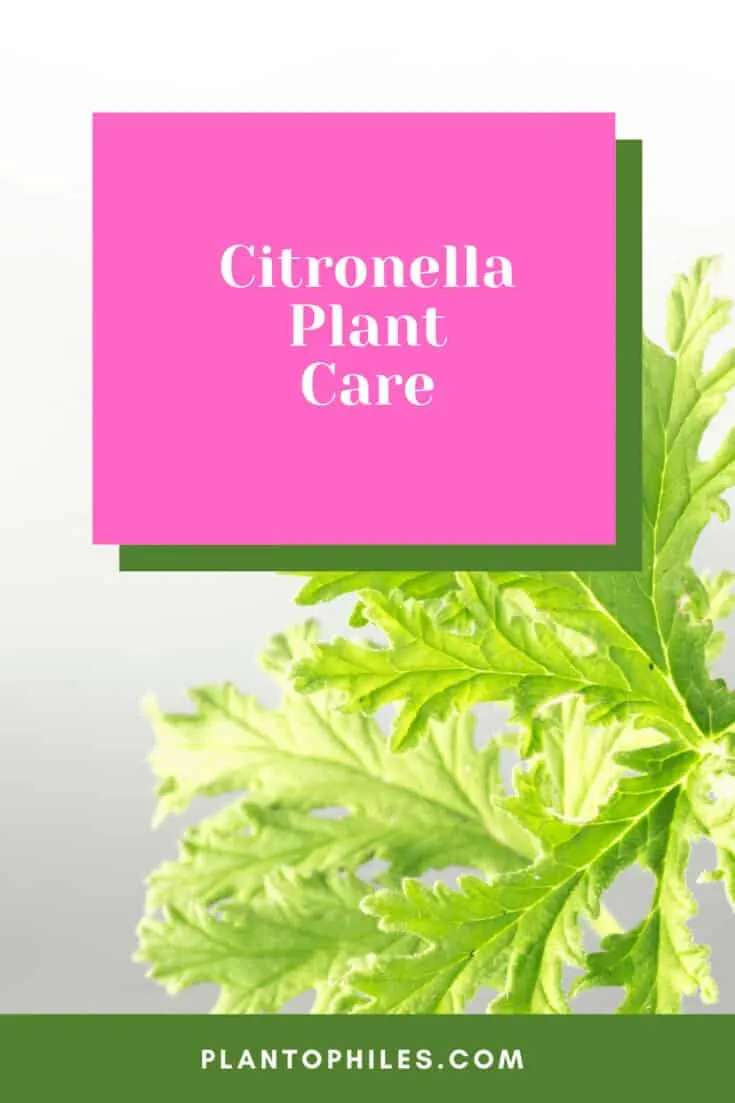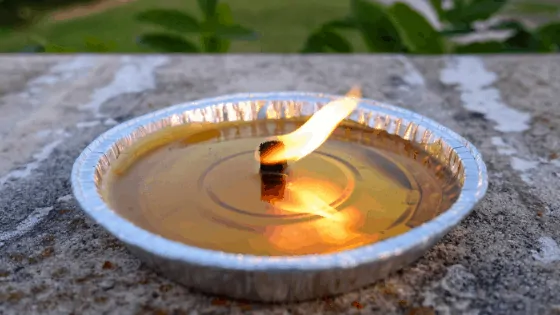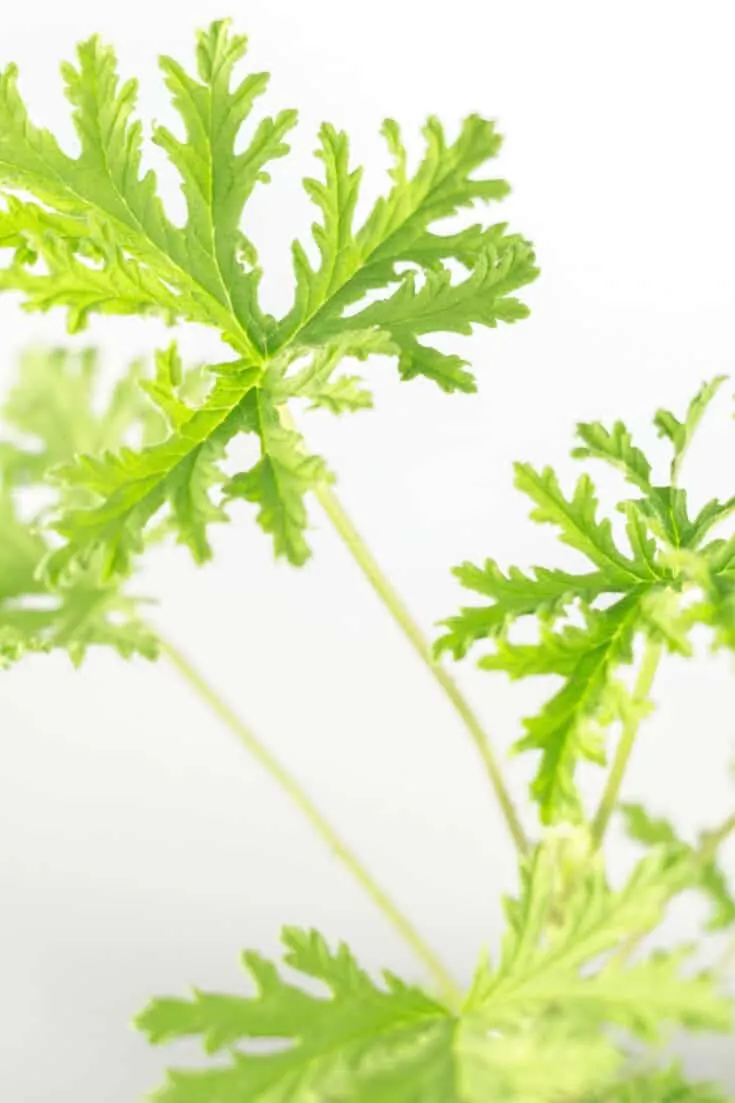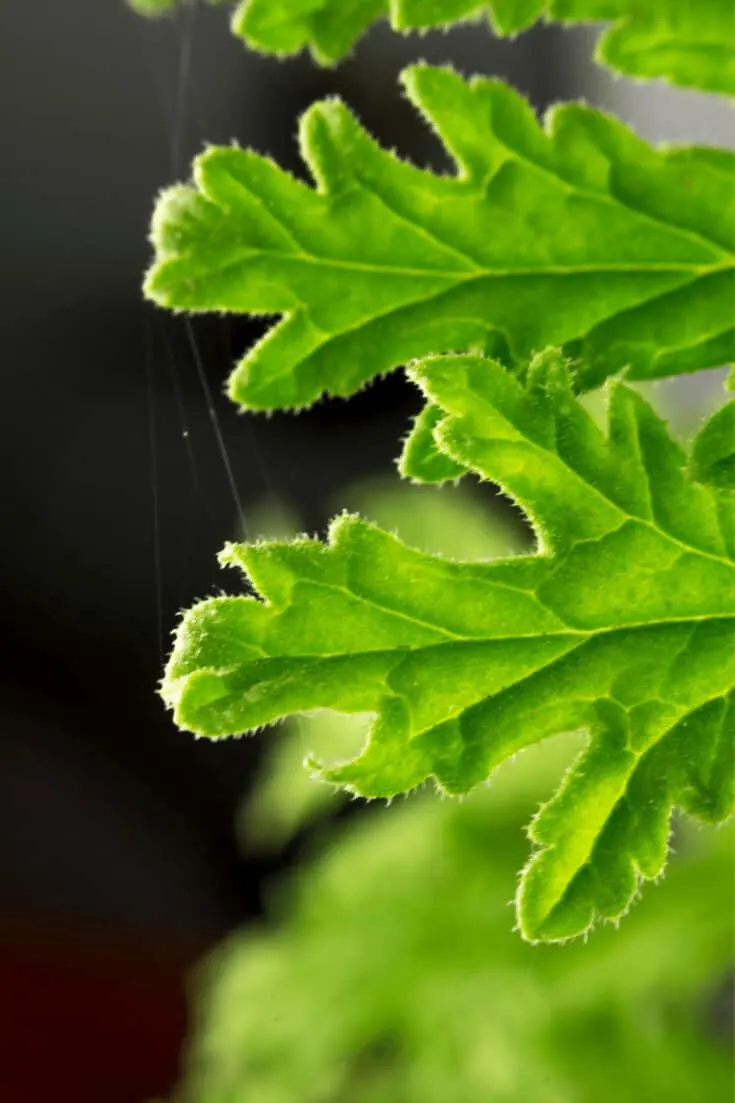The Citronella plant, also known as the Mosquito plant (Pelargonium graveolens) is a scented geranium with lacy mosquito-repellent leaves. It emits a lemony fragrant that is also used as citronella oil. Citronella belongs to the family of geraniums, where one of the key identifiers is aromatic leaves.
Table of Contents
Citronella Plant Takeaways
| Species | Pelargonium graveolens |
| Synonyms | Citronella plant,Rose geranium,Sweet scented geranium,Old fashion rose geranium,Rose-scent geranium |
| Family | Geraniaceae |
| Genus | Pelargonium |
| Growth | Erect, much-branched shrub |
| Height | 4.2 feet |
| Width | 3.2 feet |
| Soil | Rich moist and well-draining soil. |
| Watering | Water every 7 to 14 days |
| Light | Full sun |
| Temperature | 59 to 70°F |
| Humidity | 40-70% |
| Fertilizer | Fertilize 4 times per month |
| Propagation | Stem cuttings |
| Toxicity | Little to no toxicity. Non-toxic to animals such as cats and dogs and humans |
Citronella plant Care
To care for a citronella plant provide bright direct sunlight and at least 5-6 hours of full sun a day. Use nutrient-rich well-draining soil. Water when the top 1” of soil dries out (2.5cm) and ensure a temperature between 59-70°F (15 -21°C). 40-70% humidity is best. Fertilize once a month in spring and summer using a balanced water-soluble fertilizer of NPK 5-5-5 or 10-10-10.

Citronella Plant
The foliage is reminiscent of lace with a light green color. They d bloom small flowers that are either pink or lavender in color.
Pelargonium graveolens is found naturally in the tropical environments of Asia, where people first discovered its amazing and multifunctional uses.

Growing Citronella Plant
The care for citronella plants is easy. They are best cared for as potted plants so you can bring your citronella plant outdoors in early summer and keep the plant indoors over the winter. Well-suited is window boxes.
Planting
Plant in spring and put multiple plants 18 to 24 inches apart. Growing in the ground is possible but then winter protection is necessary. Alternatively the plants can be moved indoors over winter.
Soil
The Citronella plant requires rich, moist, and well-draining soil to thrive.
It isn’t all too picky in terms of the soil that you choose. The main requirement is that the soil should be kept relatively moist and that it can drain properly.
Pick a potting mix that is high in nutrients.

Light
The Citronella plant needs full sunlight and at least 5-6 hours of direct sunlight a day.
The Pelargonium graveolens belongs to the Geranium family. Geraniums, in particular, are known for their love of sunlight. Without proper exposure, the flowers will lack vibrancy and overall appearance.
The Mosquito plant needs plenty of full sunlight with some afternoon shade and therefore is an ideal plant for the outdoor gardener.
If grown indoors, you need a spot with lots of bright light such as a south-facing window. Alternatively, you can use a grow light.

Watering
Water the Citronella plant whenever the top 1” of soil dries out (2.5cm). It grows best in saturated soil.
As a general rule water about once every 1-2 weeks in summer.
Mosquito plant plants need a good amount of water to stay happy.
In fact, they prefer to have their soil kept fairly saturated.
The frequency of your watering sessions should be planned out in accordance with the other needs.
If your flora is in a spot that gets plenty of full sunshine, more water may be required.
Temperature
The ideal temperature for a Citronella plant is 59-70°F (15 -21°C). It grows in USDA hardiness zones 9b through 11.
Found naturally in Asia’s tropical areas, this plant can be grown indoors and outdoors if temperatures allow.
Temperatures that extend below freezing can be detrimental. Therefore grow citronella grass as a container-grown plant and bring your citronella indoors during the winter months.
As citronella grass is a perennial you can care for it for multiple years and overwinter it indoors.
Humidity
Provide 40-70% humidity for a Citronella plant.
With their natural habitat being a tropical forest, the Mosquito plant needs to be grown in a place that does have some humidity.
Luckily, the average household does have the ideal humidity, at about 40 to 70 percent.
There are ways in which you can increase the amount of moisture in the air without overwatering the root system. Adding a humidifier, or misting the leaves can be useful.
It’s also beneficial to keep in mind how much sunlight your plant is getting.
Higher temperatures will often suck the moisture out of the air, thus lowering the overall humidity.
Low ranges can halt blooms, so it’s best to keep ahead of them.
Fertilizer
For the Citronella plant use a balanced water-soluble fertilizer of NPK 5-5-5 or 10-10-10 once a month in spring and summer. Fertilizing citronella in autumn and winter is not necessary.
The occasional use of fertilizer is not a bad thing for Mosquito plant plants.
Geraniums are known for needing added levels of Nitrogen in order to increase their growth production.
Whenever you choose to add fertilizer, do so in the growing season.
It should also be water-soluble and balanced, preferably either 5-5-5 or 10-10-10.
One teaspoon of fertilizer for every square foot is ideal.
Propagation
Propagate a Mosquito plant using stem cuttings.
Among the several methods associated with propagation, Geranium plants are more successfully cloned through stem cuttings.
You can also propagate Mosquito plant plants in the water, from seedlings, or through division.
If you’re still unsure of which technique you should use, read further on for our steps on stem cuttings!

Growth
Citronella plants grow up to 5-6 feet tall (1.5-1.8m) and 3-4 feet (90-120cm) wide according to the University of California.
These floras are classified as perennial grass, meaning that they don’t really grow to be all that large.
It takes them about four to six weeks to reach their full size.
Mosquito plant plants, upon hitting full maturity, reach about two to three feet in height.
They can also spread out with a width of four feet.
Keeping them indoors is not a problem since they will take up a small corner of your counter space.
Potting
Transfer Mosquito plants to a bigger pot once every 3-4 years.
It may take a while, but Pelargonium graveolens can grow to be quite leggy.
When left unattended for too long, blooms will diminish.
Pruning is one way that you can keep these individuals healthy. Another technique is transplanting or repotting.
This will stop the roots from growing out to be too long, thus affecting the overall health of the plant.
Watering a Mosquito Plant
On average, you can expect to water your Mosquito plant once every 7-14 days. Stick your finger into the top 1-inch of soil (2.5cm). If it is dry, then you should water enough water to fully saturate the soil to the roots.
Mosquito plants prefer to remain on the drier side.
This does not mean that they like to dry out, however. They still need a fair amount of moisture in order to survive.
Overall, plant enthusiasts agree that Mosquito plants like to have about 30 inches of water annually.

Propagating Your Citronella Plant
There are several methods that you can choose to propagate your Geranium, but stem cuttings are the best method to propagate a Citronella.
Choosing to copy the parent plant through division is not all that successful, with the roots failing to root. Here are the steps to propagate your plant from stem cuttings.
Propagation Through Stem Cuttings
- Start out by finding the plant that you would like to copy, preferably one without dead foliage, and that smells quite fresh.
- Take clean, sharp scissors and make incisions on a stem just below the node. These cuts should be about four to six inches in length.
- Any leaves that are located towards the end of the stem should be carefully stripped.
- Place the stem cuttings with the open side down, into a pot with fresh soil.
- Water the new individual thoroughly and set it in a spot with bright, indirect sunlight.
- Check on the new individuals, watering whenever the soil feels dry. This should take about a week or two. From there, transfer it to a larger pot.
Mosquito Plant Pest Problems
You may have heard that Mosquito plants get their name due to their repelling properties.
Although somewhat successful in that regard, they actually do not fully deter mosquitoes from invading your home.
But, do these individuals have pests of their own?
As far as actually being under attack by bugs themselves, these Geraniums don’t have to worry.
They do a pretty good job of keeping beetles, squash bugs, hornworms, aphids, and whiteflies at bay. What they have to worry about most are diseases.
Leaf blight is the most deadly disease that you could find in your Mosquito plant.
The best way to tackle such a problem is to use specifically designed fungicides. If you catch it early enough, it won’t take many treatments.
Sad Mosquito Plant Signs
The Mosquito plant, as a whole, is relatively hardy.
That, however, does not make them immune to certain problems and issues.
Knowing what to look for ahead of time can save your plant from serious harm later down the road.
TELLTALE SIGN #1: LEAVES DROOPING
Cause: Leaves that look a bit sad and tend to droop are a clear indicator that your Geranium is experiencing soil that is dried out.
Remedy: To fix the drooping of the plant’s foliage, attempt to alter your watering schedule.
I suggest that you do this in increments, as Pelargonium graveolens is sensitive to too much water.
TELLTALE SIGN #2: YELLOW FOLIAGE
Cause: If you notice yellowing of the leaves on your citronella, you should assume that your Mosquito plant is battling with overwatering.
Remedy: The best solution is to let your plant dry out, followed by an adjusted watering schedule. It might take a while to find the right routine.
TELLTALE SIGN #3: BLACK SPOTS
Cause: Black spots on the leaves usually occur in combination with the browning of lower leaves. These are hints that your plant is grappling with too much sun exposure.
Remedy: Remember that these floras prefer bright, indirect sunlight. Moving your plant to a spot that gets less sun is usually a better move.
TELLTALE SIGN #4: CURLING LEAVES
Cause: White spots and the curling of the leaves can be a sign that you may not be providing enough sunlight for your Mosquito plant.
Remedy: Find a spot in your house that gets plenty of sunshine, preferably one near a large window.
Even full sunlight for six to eight hours each day is perfectly fine for these individuals.
- A temperature between 15 and 21 degrees Celsius is ideal.
- Keep the humidity relatively high through the use of humidifiers and misters!
- Look out for signs of blight so that you can tackle it with fungicides early on.
Is Citronella Mosquito Repellant?
Iowa State University is citing several experts who seem to claim that the effect might not be as big.
They state in the research that only 0.09 percent citronella is present in the plant. An amount too small to have a real effect.
5 Takeaways For A Healthy Mosquito Plant
Although fairly resilient, the Mosquito plant does have preferences. Keeping these five takeaways in mind will help keep your tropical perennial happy:
- Give them loads of full, direct sunlight, even from inside!
- Watch your watering ways, making sure that the plant is not getting too much moisture so that the roots will become waterlogged.
- A temperature between 59-70°F (15 -21°C) is ideal.
- Keep the humidity relatively high through the use of humidifiers and misters!
- Look out for signs of blight so that you can tackle it with fungicides early on.
Does the Citronella Repel Mosquitoes?
The Iowa State University cites several experts that claim that the mosquito repellent effect is not as big as suggested. They state in the research that the amount of citronella present in the plant is only 0.09 percent. An amount too small to work as a repellent. So is it true that they don’t repel mosquitoes?
Citronella is widely used as citronella candles and rub-on products to deter mosquitoes where the concentration of citronella is increased. It is said to work best when the leaves are crushed and then rubbed onto the skin. This way citronella grass does really repel mosquitoes although the effect might not be as big as claimed.
Frequently Asked Questions About The Citronella Plant
Does a Citronella plant really work?
As a whole, these floras do actually work to help deter bugs from invading your home. A Citronella plant emits a smell that is unappealing for such bugs. There are, however, other plants that have a higher success rate.
Does a Citronella plant grow back every year?
Being a perennial, the Citronella plant does in fact come back annually. In some areas of the world, it is grown as an annual, so just be sure to do your research.
How do you prune a Citronella plant?
Pruning is a great way to stop your Citronella plant from becoming too leggy. To do so, you can pinch back the stems once they reach anywhere longer than four inches in length. You’ll want to pinch above the leaf to remove any stems. There should be at least three leaves per stem for a healthy plan^^^’^’^
Conclusion About Citronella Plant Care
To care for a Citronella plant:
- Light: Bright direct sunlight
- Soil: Nutrient-rich, well-draining soil
- Watering: When the top 1” of soil dries out (2.5cm) about once every 1-2 weeks
- Temperature: 59-70°F (15 -21°C)
- Humidity: 40-70%
- Fertilizer: Balanced fertilizer once a month in spring and summer

Daniel has been a plant enthusiast for over 20 years. He owns hundreds of houseplants and prepares for the chili growing seasons yearly with great anticipation. His favorite plants are plant species in the Araceae family, such as Monstera, Philodendron, and Anthurium. He also loves gardening and is growing hot peppers, tomatoes, and many more vegetables.


